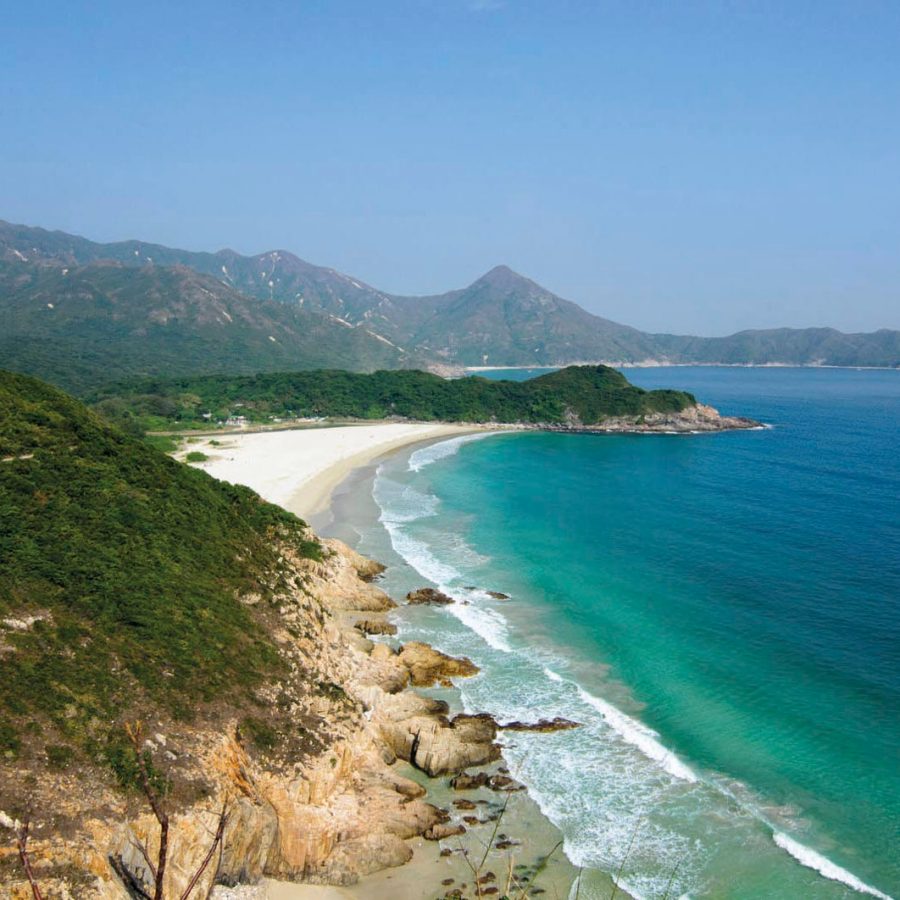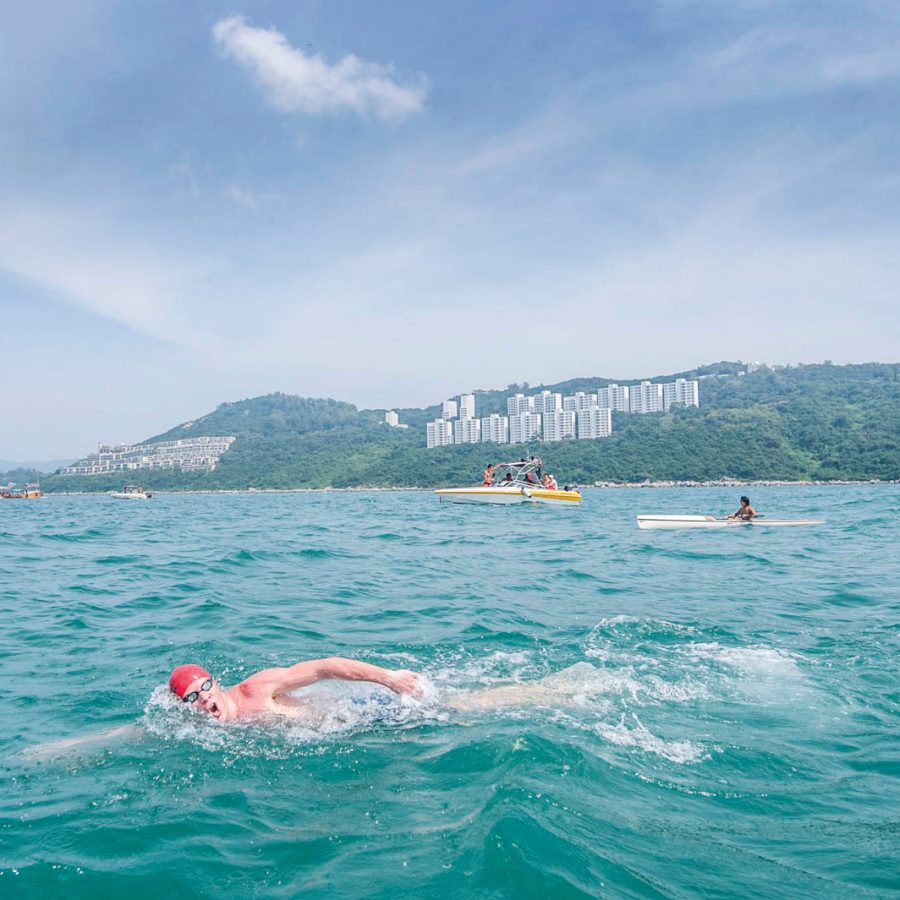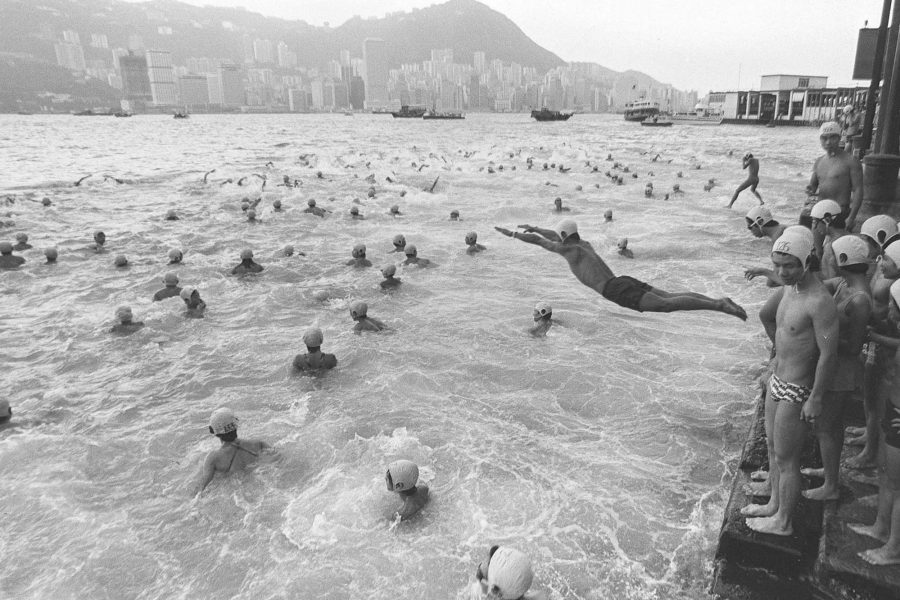When Ronnie Wong wants to swim, he heads to the sea. ‘It feels totally different to swimming in a pool,’ says Wong, who swam for Hong Kong in the 1968 and 1972 Olympics. ‘You can see the mountains in front of you. You feel freedom.’
Every year, millions of people plunge into the warm waters of the city’s bays, coves and channels. This might be one of the world’s most expensive cities to live in, but the beach is always free – and the territory’s long, craggy coastline means there are 733 kilometres of opportunities for a dip.

Credit: Raquel Mogado/Alamy Stock Photo
Some of the earliest public beaches were surprisingly close to the city centre. A century ago, people living in the crowded tenements of Central and Sheung Wan took the tram out to North Point, where a long stretch of sand spilled into the azure waters of Victoria Harbour. A pair of thatched huts offered changing facilities.
The Kowloon equivalent was Lai Chi Kok, with a beach facing the hills of Stonecutter’s Island. Amusement parks were built next to both beaches in 1949. The shortlived Luna Park stood in North Point until 1954, while Lai Yuen amusement park overlooked Lai Chi Kok Bay until 1997.
People with cars preferred the beaches along the Rambler Channel or on the southside of Hong Kong Island. Friends and families pooled their money to rent a matshed, a waterside shack with a verandah and changing facilities, and would spend the day camped out.
‘Repulse Bay was the most popular beach [...] and crowded on a Sunday,’ wrote young English expat Betty Steel in a 1930 diary entry. ‘When walking on the beach we wore pretty floral beach pyjamas or shorts, made by our Chinese tailor. Behind the matsheds, lining the beach road, flame of the forest trees were in full bloom.’
Not long after Steel’s diary entry, a new entertainment pavilion on Repulse Bay called the Lido offered public changing facilities – a more affordable alternative to renting a matshed. Crowds swelled as Hong Kong’s population boomed after the Second World War, to the point where Repulse Bay’s strip of sand was thoroughly saturated with half-naked bodies – a literal twist on the Chinese expression yan san yan hoi (‘people mountain people sea’).

With the people came a surge in pollution. Sewage and industrial waste were pumped directly into the ocean, and by the 1980s, the water at many beaches was rancid. Li Kwan-yu, a factory manager who learned to swim at Tsuen Wan’s Lido Beach in the 1960s, remembers the water was so murky ‘it looked like milk tea’.
Those who could stand the filth were scared off by sharks in the 1990s. For a time, Hong Kong was one of the world’s worst places for shark attacks, with six fatal maulings between 1991 and 1995. In response, the government installed shark nets at 41 of the city’s public beaches, and there haven’t been any attacks since – but some conservationists say the lack of shark activity has less to do with the nets than with overfishing in the South China Sea.
At the same time, new sewerage projects have vastly improved Hong Kong’s water quality. Nearly 11 million people visited the city’s beaches in 2016 – an increase of 27 per cent over the previous decade.
In October 2017 the government gave the green light for the annual cross-harbour race to return to the original Tsim Sha Tsui to Wan Chai route. The event had been suspended in 1979 due to fears over water quality, until 2010 when it was reinstated further east nearer the South China Sea. Almost 3,000 swimmers gave their seal of approval, plunging into Victoria Harbour to complete the one kilometre route.
Hong Kong’s best swimming spots
Repulse Bay
This southside beach is popular for a reason: it’s clean, spacious, convenient and, despite the large number of people who visit every year, rarely too crowded.
Hap Mun Bay
Hong Kong’s least polluted beach , according to data from the Environmental Protection Department, this beach on Sharp Island in Sai Kung has crystal-clear azure water.
Kwun Yam beach
Overlooked by most visitors to Cheung Chau, this secluded cove comes with a great view of Hong Kong Island. There’s also the Hing Kee Beach Store, a seaside cafe that has been run by the same family for more than 70 years.
Cheung Sha
Hong Kong’s longest public beach , this stretch of sand runs for nearly three kilometres along the southern shore of Lantau Island.
Ham Tim
Located on Sai Kung’s Tai Long Wan (‘Big Wave Bay’), Ham Tin is a 90 minute walk from the nearest road. You’ll be rewarded by a scene that looks more like Hawaii than Hong Kong.
Hong Kong travel information
- China – the Chinese Mainland, Hong Kong SAR, Macao SAR and Taiwan Region
- Hong Kong SAR - English
- Chinese Mainland (China) - English
- Taiwan, China - English
- 香港特別行政區 - 繁體中文
- 中国內地 - 简体中文
- 中國台灣 - 繁體中文
- Africa
- South Africa - English
- Asia
- Bangladesh - English
- Korea - English
- Singapore - English
- Cambodia - English
- 한국 - 한국어
- Sri Lanka - English
- India - English
- Malaysia - English
- Thailand - English
- Indonesia - English
- Maldives - English
- ประเทศไทย - ภาษาไทย
- Indonesia - Bahasa Indonesia
- Myanmar - English
- Vietnam - English
- Japan - English
- Nepal - English
- Việt Nam - tiếng Việt
- 日本 - 日本語
- Philippines - English
- Australasia
- Australia - English
- New Zealand - English
- Europe
- Belgium - English
- France - Français
- Россия - Русский
- Denmark - English
- Ireland - English
- Schweiz - Deutsch
- Deutschland - Deutsch
- Italia - Italiano
- United Kingdom - English
- España - Español
- Nederland - Nederlands
- Middle East
- Bahrain - English
- Saudi Arabia - English
- United Arab Emirates and Qatar - English
- Israel - English
